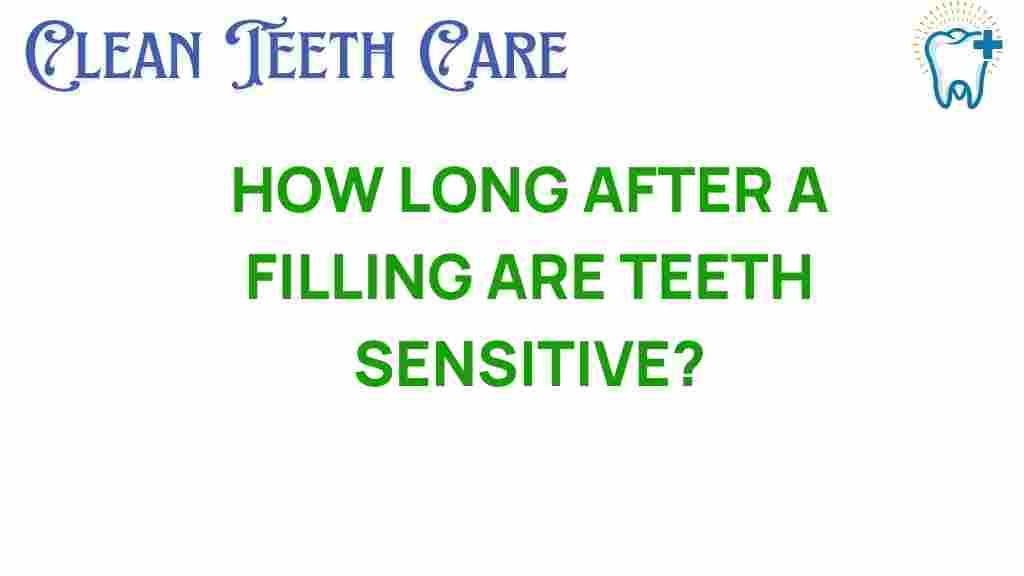Unraveling the Mystery: How Long Are Teeth Sensitive After a Filling?
Teeth sensitivity is a common issue that many patients experience after undergoing dental procedures, particularly after receiving dental fillings. Understanding the duration and nature of this sensitivity can significantly enhance your overall oral health and improve your patient experience. In this article, we will delve into the reasons behind teeth sensitivity following a filling, what to expect during recovery, and essential post-filling care that can alleviate tooth pain.
Understanding Teeth Sensitivity
Teeth sensitivity is characterized by discomfort or pain in the teeth when exposed to certain stimuli, such as hot or cold temperatures, sweet or acidic foods, or even cold air. This condition can arise from various dental issues, including worn enamel, gum recession, and of course, the aftermath of dental fillings.
Why Do Teeth Become Sensitive After a Filling?
After a dental filling, it’s not uncommon for patients to experience some level of sensitivity. This sensitivity can occur due to several reasons:
- Nerve Irritation: Dental fillings can irritate the nerves in the tooth, leading to temporary discomfort.
- Change in Tooth Structure: The process of drilling and filling can alter the tooth’s structure, causing sensitivity.
- Type of Filling Material: Some filling materials, especially those that are more rigid, can lead to increased sensitivity.
- Post-Procedure Trauma: The physical manipulation during the procedure can cause temporary inflammation and sensitivity.
How Long Does Teeth Sensitivity Last After a Filling?
The duration of teeth sensitivity after a filling can vary from person to person and depends on several factors, including:
- Type of Filling: Composite fillings may result in more sensitivity compared to amalgam fillings.
- Depth of the Cavity: Deeper cavities may cause prolonged sensitivity as more tooth structure is involved.
- Individual Pain Tolerance: Each individual’s pain threshold can influence their perception of sensitivity.
Typically, teeth sensitivity after a filling can last from a few days to a couple of weeks. In most cases, the sensitivity will gradually decrease as the tooth heals. However, if sensitivity persists beyond this period, it may indicate a need for further dental evaluation.
Post-Filling Care: Tips to Alleviate Sensitivity
Taking proper care of your teeth after a filling can help minimize sensitivity and promote faster recovery. Here are some essential post-filling care tips:
- Avoid Extreme Temperatures: Refrain from consuming hot or cold foods and beverages for at least 24 hours post-procedure.
- Use Sensitivity Toothpaste: Opt for toothpaste specifically designed for sensitive teeth, which can help reduce discomfort.
- Practice Good Oral Hygiene: Maintain regular brushing and flossing to keep your mouth healthy, but be gentle around the filled area.
- Limit Sugary Foods: Avoid sugary and acidic foods that can exacerbate sensitivity.
- Follow Dentist’s Instructions: Always adhere to any specific instructions provided by your dentist after the procedure.
What to Expect During Recovery Time
Recovery time after receiving dental fillings can vary based on the individual and the complexity of the procedure. Here’s a general timeline of what you might experience:
- Immediately After the Filling: Expect numbness in the mouth due to anesthesia; sensitivity may begin once the numbness wears off.
- First Few Days: Sensitivity may be at its peak; discomfort is common while your tooth adjusts to the filling.
- One Week Later: Sensitivity should start to diminish; if it persists, consult your dentist.
- Two Weeks Post-Procedure: Most patients report reduced sensitivity and a return to normal function.
Troubleshooting: When to Consult Your Dentist
While some sensitivity is expected, there are specific signs that indicate the need for a dental visit. You should reach out to your dentist if:
- Sensitivity Persists Beyond Two Weeks: If your teeth remain sensitive after two weeks, it may indicate a deeper issue.
- Intense Pain: Severe tooth pain that interferes with daily activities should be evaluated.
- Swelling or Infection Signs: Look for swelling in the gums or any signs of infection around the filling.
- Difficulty Chewing: If chewing becomes painful, there may be an issue with the filling itself.
Addressing these concerns promptly can help prevent further complications and ensure the best outcome for your oral health.
Dental Advice for Managing Sensitivity
Managing teeth sensitivity after a filling can be challenging, but with the right dental advice, you can navigate this period more comfortably. Here are some tips:
- Stay Hydrated: Drink plenty of water to keep your mouth hydrated and help flush out any irritants.
- Use a Soft-Bristled Toothbrush: A soft toothbrush can help minimize irritation to sensitive teeth.
- Consider Dental Sealants: Discuss with your dentist the possibility of applying dental sealants to sensitive areas.
- Regular Dental Visits: Schedule regular check-ups to monitor your dental health and address any emerging issues.
For more information on how to manage tooth sensitivity, you can visit this dental resource.
Conclusion
Teeth sensitivity after dental fillings is a common occurrence, but understanding its causes and knowing what to expect can significantly improve your recovery experience. By following proper post-filling care and being aware of the signs that necessitate a dental visit, you can effectively manage any discomfort and ensure your oral health remains a priority.
Remember, if you have concerns or experience prolonged sensitivity, don’t hesitate to consult your dentist for personalized advice and treatment options. Your smile deserves the best care!
For more dental tips and advice, check out our dental blog.
This article is in the category Treatments and created by CleanTeethCare Team
